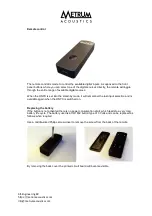
All-Engineering BV
https://metrumacoustics.com
[email protected]
Introduction
With the goal of creating a very special DAC in mind the designers of Metrum Acoustics
have developed a new DAC.
It was an unprecedented challenge, which was eventually solved by introducing an entirely
new chip, which has been exclusively developed by Metrum Acoustics.
Behind the luxurious front more than new chips are concealed:
The parallel driven R2R ladder networks as used in the eight DAC modules performs,
especially when combined with our FPGA-driven “forward correction module”, on a higher
level. This module splits up the audio samples for each channel into new separate data
streams. Each DAC cluster processes a portion of the data in the most linear region of the
DAC chips. The result of this process is an extremely high linearity, right down to -140 dB,
which gives the PAVANE a realistic 24-bit dynamic range. Due to the dual mono design over
the entire frequency range an extremely high channel separation of 120 dB is realized. This
contributes to the flawless positioning of instruments.
In short, the PAVANE is a DAC that has taken all the lessons and experiences that her
designer has learned over the years, and combined them in an ambitious DAC that can fit in
every system. It is musical, honours the Non-oversampling principle while simultaneously
incorporating the technological progress that has been made over the years.
Extreme NOS
The PAVANE by Metrum Acoustics PAVANE is the company’s flagship DAC.
The Forward correction module is splitting the 24-bit format into two new 12 bit streams. So
you have a 12 bit stream which is the LSB (least significant bits) and the 12 bit DAC (most
significant bits). The problem with 24 bits R2R ladder DAC is linearity and switching noise
of the ladder network in the lower ranges. Therefore, the LSB part will be pushed to the upper
part of the ladder by the forward correction module. In other words, the LSB will be
processed as MSB data. The advantage is that it will be processed in the area having the
lowest noise, the best linearity and the lowest distortion.
The result however is that on the analog side of these two clusters the volume of the LSB is
equal to the MSB part which is wrong, of course. Therefore, we have to attenuate the LSB
part with 67 dB (equal to 12 bits) to let it match with the MSB part. The result of this
attenuation is that switching noise is also attenuated for 67dB and that distortion and linearity
in this range is the same as in the MSB part.
All incoming data is passed through this “forward correction module” and the answer to
“What’s it correcting?” is essentially low-level linearity and noise.










